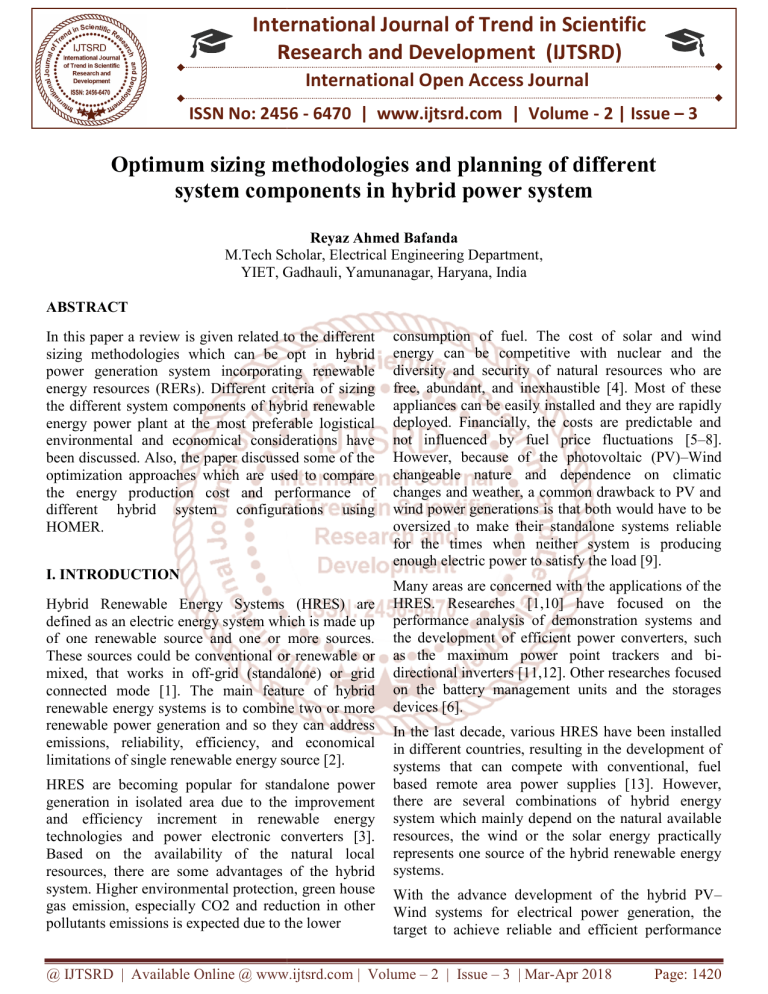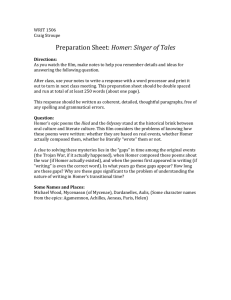
International Journal of Trend in Scientific
Research and Development (IJTSRD)
International Open Access Journal
ISSN No: 2456 - 6470 | www.ijtsrd.com | Volume - 2 | Issue – 3
Optimum sizing methodologies aand
nd planning of different
system components in hybrid power system
Reyaz Ahmed Bafanda
M.Tech Scholar, Electrical Engineering Department
Department,
YIET, Gadhauli
Gadhauli, Yamunanagar, Haryana, India
ABSTRACT
In this paper a review is given related to the different
sizing methodologies which can be opt in hybrid
power generation system incorporating renewable
energy resources (RERs). Different criteria of sizing
the different system components of hybrid renewab
renewable
energy power plant at the most preferable logistical
environmental and economical considerations have
been discussed. Also, the paper discussed some of the
optimization approaches which are used to compare
the energy production cost and performance of
different
ifferent hybrid system configurations using
HOMER.
I. INTRODUCTION
Hybrid Renewable Energy Systems (HRES) are
defined as an electric energy system which is made up
of one renewable source and one or more sources.
These sources could be conventional or renewable or
mixed, that works in off-grid
grid (standalone) or grid
connected mode [1]. The main feature of hybrid
renewable energy systems is to combine two or more
renewable power generation and so they can address
emissions, reliability, efficiency, and economical
limitations of single renewable energy source [2].
HRES are becoming popular for standalone power
generation in isolated area due to the improvement
and efficiency increment in renewable energy
technologies and power electronic converters [3].
Based on the availability of the natural local
resources, there are some advantages of the hhybrid
system. Higher environmental protection, green house
gas emission, especially CO2 and reduction in other
pollutants emissions is expected due to the lower
consumption of fuel. The cost of solar and wind
energy can be competitive with nuclear and the
diversity and security of natural resources who are
free, abundant, and inexhaustible [4]. Most of these
appliances can be easily installed and they are rapidly
deployed. Financially, the costs are predictable and
not influenced by fuel price fluctuations [5–8].
However, because of the photovoltaic (PV)–Wind
(PV)
changeable nature and dependence on climatic
changes and weather, a common drawback to PV and
wind power generations is that both would have to be
oversized to make their standalone systems reliable
for the times when neither system is producing
enough electric power to satisfy the load [9].
Many areas are concerned with the applications of the
HRES. Researches [1,10] have focused on the
performance analysis of demonstration systems and
the development of efficient power converters, such
as the maximum power point trackers and bibi
directional inverters [11,12]. Other researches focused
on the battery management units and the storages
devices [6].
In the last decade, various HRES have been installed
in different
ferent countries, resulting in the development of
systems that can compete with conventional, fuel
based remote area power supplies [13]. However,
there are several combinations of hybrid energy
system which mainly depend on the natural available
resources,, the wind or the solar energy practically
represents one source of the hybrid renewable energy
systems.
With the advance development of the hybrid PV–
PV
Wind systems for electrical power generation, the
target to achieve reliable and efficient performance
@ IJTSRD | Available Online @ www.ijtsrd.com | Volume – 2 | Issue – 3 | Mar-Apr
Apr 2018
Page: 1420
International Journal of Trend in Scientific Research and Development (IJTSRD) ISSN: 2456-6470
became complicated task. So that there is a need to
select and configure the optimum sizing of all
components in order to obtain the minimum capital
investment while maintaining system reliability to
satisfy the load [14,15]. This paper summarized three
common used sizing methods for hybrid PV–Wind
systems. Moreover, the paper will discuss some
optimization techniques of the HRES. These
techniques are used to compare the technical
performance and cost of energy for different system
configurations using simulation approaches.
One of the most powerful tools for optimal sizing of
HRESs’ equipment is Hybrid Optimization Model for
Electric Renewables (HOMER) software that was
developed by National Renewable Energy Laboratory
(NREL), United States [16]. Although HOMER
software is used in many studies. Therefore, an article
is needed that comprehensively reviews the papers
which used HOMER for optimal planning of HRESs
which is the main objective of this paper. This review
will be useful for researchers who intend to use
HOMER for planning of HRES in their regions. It
provides the required information about planning of
HRES simulated with HOMER such as what
components are considered in HRESs? How they are
used in stand-alone or grid connected modes? And
what uncertain parameters are considered in the
articles?
II. DESCRITION OF HOMER SOFTWARE
HOMER software is a powerful tool for designing and
planning of HRES in order to determine optimal size
of its components through carrying out the technoeconomic analysis. Many resources such as WT, PV
array, fuel cells, small hydropower, biomass,
converter, batteries, and conventional generators are
modeled in HOMER. HOMER also considers HRES
in grid-connected and stand-alone modes. Fig. 1
shows the typical configuration of HRES designed in
HOMER. Required input data for simulation with
HOMER and also a comprehensive framework to
show how optimal sizes of HRES׳s equipment is
determined by HOMER are described in this section.
Fig. 1. Typical schematic of a HRES in HOMER
I.
Input data
HOMER requires six types of data for simulation and
optimization including meteorological data, load
profile, equipment characteristics, search space,
economic and technical data. These data are described
in details in the following subsections.
a. Meteorological data
The meteorological data are wind speed, solar
radiation, temperature, and stream flow which are fed
into the software in the form of monthly averages or
time series data. HOMER uses these inputs data to
calculate the output power of WT, PV array and
hydropower.
b. Load profile
Load profile of each region is the most important
factor in the simulation and optimization. Some
locations such as universities, hospitals, hotels, and
industrial towns have real load consumption data,
which are appropriate for simulation. These real data
are fed into HOMER as time series data. However, in
some regions especially remote and rural areas that
the real load consumption data are not available, the
load profile should be forecasted with notice to the
specification of that region. These data are fed into
HOMER as daily profile and HOMER uses them in
power balance constraint.
c. Equipment characteristics
According to the characteristics of each equipment,
which is modeled in HOMER, efficient operation of it
@ IJTSRD | Available Online @ www.ijtsrd.com | Volume – 2 | Issue – 3 | Mar-Apr 2018
Page: 1421
International Journal of Trend in Scientific Research and Development (IJTSRD) ISSN: 2456-6470
in HRES is determined. The characteristics of HRES׳s
equipment are described in [11].
d. Search space
Since HRESs’ components including WT, PV array,
generator, battery, and converter have different sizes,
there is a search space that is considered in simulation
and optimization. For example, the equipment of a
hypothetical HRES which have different sizes is
illustrated in Table 1. So, the search space includes
5×5×5×3=375 plans (combination of different
equipment) that the simulation and optimization
stages will be done for each of them.
Table 1. Search space for a hypothetical case study
Component
WT
PV
Battery
Converter
(number) array (number) (kW)
(kW)
Maximum
Minimum
Step
4
0
1
40
0
10
40
0
10
40
0
20
e. Economic data
Each equipment in HRES has some cost data such as
operation and maintenance, capital, and replacement
cost. Fuel price, price of transaction electricity with
the grid, real interest rate, project lifetime, system
fixed capital cost, system fixed operation and
maintenance cost, and emissions penalty are the other
economic data that can be considered in HOMER.
These costs are considered in simulation and
optimization stages and based on them, the Net
Present Cost (NPC) of each plan is calculated.
f. Technical data
For simulation, HOMER requires some technical data
including dispatch strategy, MACS, MREF, and
operating reserve, which are described in [11].
g. HOMER optimization procedure
After the input data are fed into HOMER, which was
described in previous section, optimal sizes of
HRES׳s equipment are determined in three stages
including simulation, optimization, and sensitivity
analysis as described in Fig. 2. These stages are
introduced in the following subsections. Simulation
and optimization stages are done simultaneously.
II.
Simulation and optimization
For each plan from search space the optimization and
simulation stages are done. The objective function is
minimized subject to the constraints. The objective
function of each plan is the total NPC which is the
present value of the sum of costs minus the sum of
revenues. The costs are the cost of energy purchased
from the grid, initial cost, replacement cost, operation
and maintenance cost as well as the fuel cost. The
revenues are the revenue from energy sold to the grid
and the salvage value. Constraints are power balance
constraint, charging and discharging constraints of
battery, constraints of transaction energy with grid,
technical constraints of generators and so on. For the
feasible plans the required output is calculated
including the NPC, operation results of resources such
as generator, battery, and converter in each time step,
the energy transacted with the grid, and the emissions
produced. Feasibility means that the power balance
constraint is satisfied in each time step. In fact, the
demand of each time step is supplied. At the end, the
feasible plans are sorted according to the minimum
NPC so that the first plan has the minimum NPC and
is considered as the best plan.
a. Sensitivity analysis
In optimal sizing procedure of HRES׳s equipment,
some parameters such as fuel cost, wind speed, solar
radiation, electricity price, and components cost have
not deterministic values. So, the uncertainty of these
parameters has effect on simulation and optimization
stages. These parameters are fed into HOMER with
different values. When the simulation and
optimization stages are done and the feasible plans are
sorted according to the minimum NPC, the sensitivity
analysis is done as shown in Fig. 2. For each uncertain
parameter the simulation and optimization stages are
repeated and the new feasible and best plans may be
obtained. To evaluate the effect of uncertain
parameters on the results, two criteria including robust
planning and risk of planning are proposed in [12,13].
These criteria can be calculated by the researchers
according to the methodologies which are described
in [12,13] and HOMER software is not able to
calculate them. HOMER also produces appropriate
figures to show how the best plans’ output will be
changed with uncertain parameters.
III.
Equipment modeled in HOMER
In this section, various HRES׳s equipment modeled in
HOMER and used in different articles is presented.
Loads, components, and grid are three types of the
HRES׳s equipment, which are modeled in HOMER.
a. Loads
HRES should meet the load requirements in each time
step. Electrical, thermal, and hydrogen loads are
@ IJTSRD | Available Online @ www.ijtsrd.com | Volume – 2 | Issue – 3 | Mar-Apr 2018
Page: 1422
International Journal of Trend in Scientific Research and Development (IJTSRD) ISSN: 2456-6470
modeled in HOMER. Electrical loads are primary and
deferrable loads. Primary loads are the electrical load
that must be met in certain time while deferrable load
is the electrical load that must be met within some
time period, but the exact time is not important. Peak
and types of different loads that are used in different
articles are listed in Table 2. Also, Table 2 shows the
locations and countries which are considered in each
article. Locations that are listed for each article, such
as remote area, rural, and village are exactly
mentioned in the same article.
In most articles the effect of uncertain parameters on
NPC, operation results of resources, production of
emissions and other parameters of best plans are
evaluated. Moreover, sensitivity analysis is done in
details in recent papers. Effects of real interest rate,
fuel price, and primary load on output results is
investigated through different scenarios. The
simultaneous effects of wind speed and solar radiation
on CoE. To investigate the effect of uncertain
parameters on the NPC, an appropriate spider graph is
presented. However, as mentioned before, to evaluate
uncertain parameters and their effect on optimal
sizing of HRES׳s equipment, two appropriate criteria
including robust planning and risk of planning should
be considered. Scenario technique is one of the
appropriate approaches in dealing with the
uncertainties in planning of HRES. To this end, at
first, uncertain parameters and their different values
that may occur in the future is determined and based
on them, the scenarios can be constructed. For
example, in one project the uncertain parameters and
their different values may be considered.
b. Components
In HOMER, each part of HRES that can produce,
deliver, convert, or save energy is named as a
component. Ten components are modeled in the
HOMER. WT, PV, and small hydropower are three
renewable energy and non-dispatchable resources.
Generators, grid, and boiler are three dispatchable
resources. Converter and electrolyzer are components
that convert electrical energy to other forms. AC and
DC power are converted to each other using
converters and electrolyzers consume AC or DC
power and generate hydrogen through electrolyzing V.
DISCUSSION ON HOMER
water. Batteries and hydrogen tanks are components After all required data are fed into HOMER and the
that store energy. HRES that are modeled in the simulation and optimization stages are done, the
articles have used different components for results of each plan including the NPC ($), the initial
capital cost ($), the operation cost ($/yr), renewable
simulation.
fraction (percent), CoE ($/kWh), and emissions
c. Grid
produced (kg/yr) are calculated. Although best plan is
Grid is modeled in the HOMER in three modes, determined according to the minimum NPC by
namely, grid-connected, stand-alone, and compare HOMER, the best plan may be selected with notice to
stand-alone system with grid extension. Table 4 the other criteria considering the investors’
shows different modes of HRESs used in the articles. perspective.
In grid connected mode price and sell back of
electricity should be fed into HOMER in two types, CoE is an appropriate criterion to choice the best plan
real time prices and scheduled rates. In compare that is used in the literature. This criterion indicates
stand-alone system with grid extension mode, the average cost per kWh of each plan to supply the
breakeven grid extension distance will be calculated demand. The CoE is high in some cases due to high
using three inputs including capital, operation and investment cost of component, high fuel prices, high
maintenance cost and grid power price. The distance from the main grid and so on. For
breakeven grid extension distance is the minimum electrification to remote and rural areas which have
distance from the grid that makes a stand-alone high distance from the main grid, there are two main
solutions including the extension of the main grid and
system cheaper than extending the grid.
using of HRESs. Although extension of the main grid
IV.
SENSITIVITY ANALYSIS
may lead to lower NPC in comparison with HRESs, it
To evaluate the effect of uncertain parameters on has several disadvantages including power losses, low
optimal sizing of HRES׳s equipment, sensitivity power quality, and high operation and maintenance
analysis should be done. Uncertain parameters may cost. Moreover, in some cases the grid extension in
differ with notice to the location and type of the not possible with notice to the topography of region.
components. Wind speed, solar radiation, fuel price, On the other hand, in urban areas the CoE for best
component cost, and primary load are the most plans is higher than the grid electricity prices.
uncertain parameters considered in the researches.
Therefore, to encourage the private investors to invest
@ IJTSRD | Available Online @ www.ijtsrd.com | Volume – 2 | Issue – 3 | Mar-Apr 2018
Page: 1423
International Journal of Trend in Scientific Research and Development (IJTSRD) ISSN: 2456-6470
on HRESs in rural and urban areas, the governments
should determine attractive regulations to give more
incentives to investors.
VI. Conclusions
HRESs are appropriate solution to meet the local
loads in rural, remote, and special urban regions, e.g.,
universities and hospitals. Determining the optimal
sizes of HRES׳s equipment is the major concern of
researchers. HOMER software is a powerful tool used
by many researchers around the world for optimal
planning of HRES. According to the ability and
widespread use of this software, the present paper
reviewed those articles that have used HOMER for
the optimal planning of HRES. The most remarkable
conclusions from this review are listed as follows:
The software has been used in developing
countries more than other regions, especially
in remote and rural areas.
The software has been used for wide range of
load from 0.626 kW to 2,213,000 kW.
Many combinations of dispatchable/Nondispatchable
resources,
storages
and
converters have been modeled in the articles.
PV is the popular resource considered by
many researchers.
HRESs have been modeled in stand-alone mode more
than grid connected mode.
References
1) Erdinc O, Uzunoglu M. Optimum design of
hybrid renewable energy systems: overview of
different approaches. Renew Sustain Energy Rev
2012;16:1412–25.
2) Bajpai P, Dash V. Hybrid renewable energy
systems for power generation in stand-alone
applications: A review. Renew Sustain Energy
Rev 2012;16:2926–39.
3) Bernal-Agustín JL, Dufo-López R. Simulation and
optimization of stand-alone hybrid renewable
energy systems. Renew Sustain Energy Rev
2009;13:2111–8.
4) Bhattacharyya SC. Review of alternative
methodologies for analysing off-grid electricity
supply. Renew Sustain Energy Rev 2012;16:677–
94.
5) Fathima AH, Palanisamy K. Optimization in
microgrids with hybrid energy systems—a review.
Renew Sustain Energy Rev 2015;45:431–46.
6) Kaundinya DP, Balachandra P, Ravindranath NH.
Grid-connected versus stand-alone energy systems
for decentralized power—a review of literature.
Renew Sustain Energy Rev 2009;13:2041–50.
7) Mahesh A, Sandhu KS. Hybrid wind/photovoltaic
energy system developments: critical review and
findings.
Renew
Sustain
Energy
Rev
2015;52:1135–47.
8) Shivarama Krishna K, Sathish Kumar K. A review
on hybrid renewable energy systems. Renew
Sustain Energy Rev 2015;52:907–16.
9) Upadhyay S, Sharma MP. A review on
configurations, control and sizing methodologies
of hybrid energy systems. Renew Sustain Energy
Rev 2014;38:47–63.
10) Lambert T, Gilman P, Lilienthal P. Micropower
system modeling with homer. Integration of
alternative sources of energy. John Wiley & Sons,
Inc.; 2006. p. 379–418.
11) Andrews CJ. Evaluating risk management
strategies in resource planning. IEEE Trans Power
Syst 1995;10:420–6.
12) Laimes YY. Risk modeling, assessment, and
management. John Wiley & Sons; 2005.
13) Blackler T, Iqbal MT. Pre-feasibility study of
wind
power
generation
in
Holyrood,
Newfoundland. Renew Energy 2006;31:489–502.
14) Khan MJ, Iqbal MT. Pre-feasibility study of
stand-alone
hybrid
energy
systems
for
applications in Newfoundland. Renew Energy
2005;30:835–54.
15) Nfah EM, Ngundam JM, Vandenbergh M, Schmid
J. Simulation of off-grid generation options for
remote villages in Cameroon. Renew Energy
2008;33:1064–72.
16) ⟨http://www.nrel/gov/HOMER⟩.
@ IJTSRD | Available Online @ www.ijtsrd.com | Volume – 2 | Issue – 3 | Mar-Apr 2018
Page: 1424




